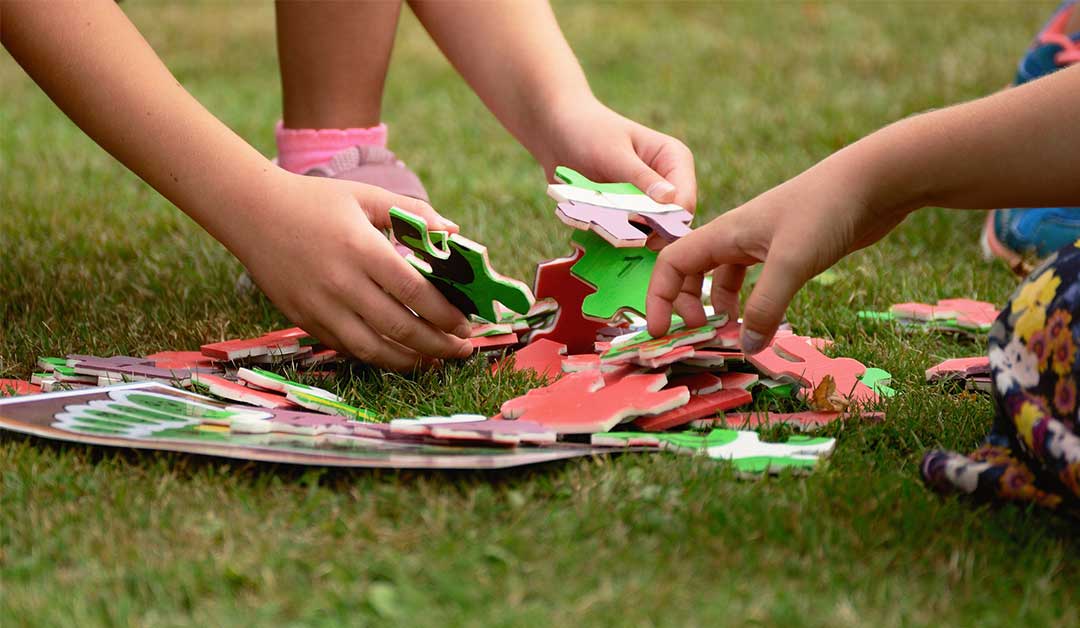After a long, dark winter suddenly… spring came? It is hard to tell but maybe it is summer already? Four – five weeks ago I was dashing to work through the snow in a down jacket but yesterday I was rushing with my bare legs in a light dress. True or not, the weather definitely encourages us to spend more time outdoors. Children also feel it that way – many teachers are complaining about children’s lack of focus and interest in lessons while there is a wonderful world awaiting outside the window. Is there a cure for it? Of course! The answer is English lessons in the fresh air. But how to teach kids English language while being outside?
First of all, where?
The key is to find a proper place. Obviously, it would be just perfect to spread a giant, fluffy blanket in the middle of a quiet park or in a secret garden. In reality not all of us can even think of such marvellous conditions. However, in order to conduct a good lesson outdoors, we need far less than that. Children care more about the variety of activities than the beauty of surrounding nature. If we can find a place that is, first and foremost, safe, secondly, quiet enough for a group to hear themselves, that will do. It is good to avoid traffic routes in places crowded with people.
Can you sit only on a blanket?
Let’s focus on the seating ‘logistics’: we can use a blanket, if there is soft grass, or a mat or a carpet placed on a pavement, or even small chairs, poufs, foam puzzles which children can carry themselves. It is a bit like a picnic: we do not organise it because we expect the same comfort as at the table, we organise it because we are looking for a change.
We are outside – what’s next?
The last important thing is the course of the lesson itself. As far as we can agree on relaxation of some rules, we cannot waste that lesson time because children have to study. Parents have paid for that hour as for any other one after all. Even if the main goal is to re-establish now fading motivation and to make children fall in love with English, the lessons must be abundant in language activities. Here are my ideas for exercises that will work every time.
Treasure hunters
Treasure hunt, escape room, chase & run – no matter which term you will use, it focuses on searching for clues and solving the puzzles. The play is about completing a certain number of tasks by children in a given amount of time (over the duration of a lesson). After completing the first task, children receive a piece of information concerning a place where more clues are hidden. Maybe under the rock on the left side of a carpet rack? Or maybe in a post box? That piece of information can constitute an answer to a previous mystery or, which requires more commitment from a teacher (but in my opinion it’s worth it!), a reward in exchange for a correct answer given by a child.
How does it look like in reality? Let’s assume that the first task is to name the animals in the pictures. Under each picture there are blank boxes in an amount corresponding to the number of letters in a word. In the first option, each letter has a number assigned. After giving a name to an animal, children copy the letters with certain numbers to the table with a key to the riddle. Those letters make up a clue, for example: UNDER THE BENCH. Now, the children know where to look for the next riddle. In the second option, the children give a completed task to a teacher who, in return, tells them where they can find more clues.
Keep in mind that this kind of play has to be arranged with an extra time provided – it is better to have some time at the end of a class to sing a favourite song or to play a different game, than to run out of time allocated for searching for clues. Children should experience a sense of achievement – after completing the last task there should be a reward, a certificate, sweets or a link to a funny video on YouTube awaiting for them.
Chain of questions
This game is ideal to conduct outdoors because it is important that playing children can hear only a person who they are working with in a pair. This exercise can be conducted orally or in writing depending on the children’s level of proficiency and the material that we want to practice. We divide the class into two groups. We ask children with number one from each pair a question, for example What’s your favourite colour? Then, those children approach the second person from a group and tell them just an answer, for instance Red. Next, children with number two come up to those in groups with number three and ask them a question which would match the heard answer. And here the creativity begins: Red is the answer to: What’s your favourite colour? but also to What colour is an apple? or What colour is the teacher’s blouse? Not to mention the fact that the answer Red can occur in only one group. The versions start to differ from each other. The third person approaches the fourth one and again they reveal only the answer, and so on. The last person goes back to the teacher, and later that chain of answers can be traced back.
If we opt for a version in writing, children can hand each other pieces of paper with a question or an answer, depending on their turn.The more advanced group, the more possibilities: this very same method can be used to practice tenses, conditionals, comparison of adjectives, etc.
Bustling dictation
This is one of my favourite games which allows us to practice reading, writing and short-term memory. It can be played in pairs and groups. We place a text at the end of a track, and on the other side of that track – there is a blank piece of paper. Group has to, as quickly as possible, rewrite the text on that paper sheet. There are several ways: one kid remembers one sentence and then, runs back to put it down, or one person remembers, runs and dictates, while the second person writes it down, and later they switch roles. It is crucial to trade places so every person gets a chance to remember the text as well as write it down. A time limit may be set.
Can we play this game with the youngest kids? Of course. But instead of the text we can use flashcards arranged in a long sequence and then, ask children to recreate that sequence on the other side of a track. The only condition is to have two identical sets of flashcards.
English ice cream
This game is really useful in terms of communication. It reflects the real situation; although, it is more difficult to conduct since it requires third-party engagement. It is about allowing children to buy ice cream, sweet or hot dog using English.
In order to conduct this play, we need to invite a seller from a local shop or snack booth to cooperate with us. If this person agrees to role-play in our game, that’s fantastic. However, sometimes it is easier to convince them to make a space behind the counter for a teacher for a couple of minutes. Children very earnestly apply in practice phrases which they have been practising only in the classroom so far.
Picnic at the Queen’s
The teacher brings a bag of clothes – the more elegant the clothes, the better: silk blouses, hats from the previous era, scarves. Most of us have them stuffed in closets. We can also ask parents to equip their children before classes (or even buy some clothes sold by weight, they are useful anyway for any classes about clothing – a small but profitable investment).
Now, when everyone is dressed and ready, we sit down and have a picnic. This play will do with both a real or pretend meal. We settle that we can only speak English with the most beautiful and mannered royal accent. If we ask children to speak like „a native speaker at the book fair”, we will achieve incredible results. We can practise proposals and requests (Would you like…?, Can I have…? More…., please) but we should also encourage children to do a small talk: Oh, it’s sunny. I like it. / What a beautiful dress! / Look! A bird is flying etc.
Hear and see
This is a simple mindfulness game that does not require any preparation. We try to observe, listen and name as much from the surrounding world as we can. We may narrow down the criteria: What green things can you see? What quiet things can you hear?, etc. Furthermore, we can ask a person to describe something they can see so the rest of a group can guess what it was. We can also build a definition and then try to choose objects in sight matching that definition, for example: It’s taller than the car but lower than the tree – The school. The teacher. The corner shop.
Each of the aforementioned games can bring children a lot of joy, and each make them develop their language skills.
The author of this article is Sonja Górniak – an Iberian Studies graduate from the University of Warsaw. She used to be a trainee at the Cambridge University where she got her diploma in Proficiency. She has many years of in-company courses experience. She has started teaching children by accident a few years ago and she loves it with all her heart ever since. Currently she is Edu Bears educationalist and she has been training lectors, supervising them and inspiring to be more observant.
More information about Teddy Eddie method you can find here: https://edubears.com/teddy-eddie/, while the nearest accredited Teddy Eddie method centre can be found on this map: https://edubears.com/localisations/

